生物科学中英文对照外文翻译文献
关于生物技术的英文文献
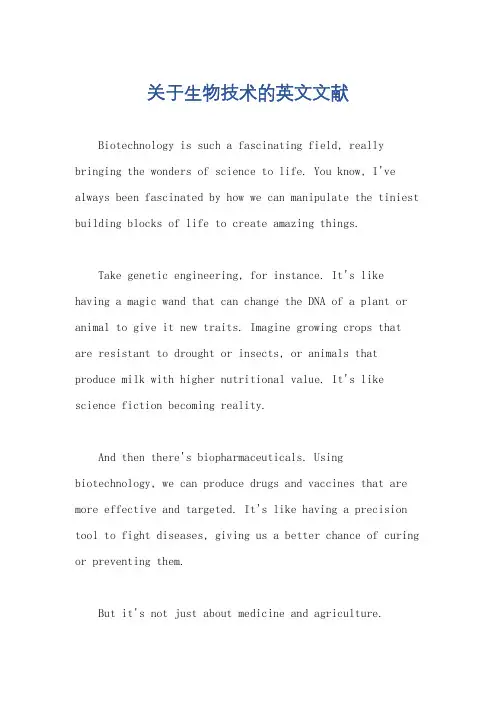
关于生物技术的英文文献Biotechnology is such a fascinating field, really bringing the wonders of science to life. You know, I've always been fascinated by how we can manipulate the tiniest building blocks of life to create amazing things.Take genetic engineering, for instance. It's like having a magic wand that can change the DNA of a plant or animal to give it new traits. Imagine growing crops that are resistant to drought or insects, or animals that produce milk with higher nutritional value. It's like science fiction becoming reality.And then there's biopharmaceuticals. Using biotechnology, we can produce drugs and vaccines that are more effective and targeted. It's like having a precision tool to fight diseases, giving us a better chance of curing or preventing them.But it's not just about medicine and agriculture.Biotechnology is also revolutionizing industries like energy and environmental protection. We can now use microbes to produce biofuels, reducing our dependence on fossil fuels and their impact on the environment.Plus, the advances in biotechnology are happening so fast. It's exciting to think about what the future holds. Maybe one day, we'll be able to regenerate organs for transplant using stem cells, or even create synthetic biology systems that can perform complex tasks.The possibilities are endless, and it's truly remarkable to be a part of this era where biotechnology is changing the world for the better. It's not just about scientific discovery; it's about improving lives and making a difference.。
微生物英文文献及翻译—翻译
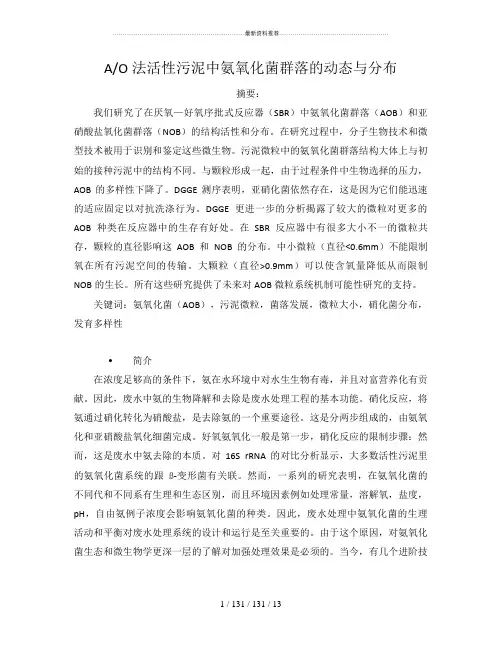
A/O法活性污泥中氨氧化菌群落的动态与分布摘要:我们研究了在厌氧—好氧序批式反应器(SBR)中氨氧化菌群落(AOB)和亚硝酸盐氧化菌群落(NOB)的结构活性和分布。
在研究过程中,分子生物技术和微型技术被用于识别和鉴定这些微生物。
污泥微粒中的氨氧化菌群落结构大体上与初始的接种污泥中的结构不同。
与颗粒形成一起,由于过程条件中生物选择的压力,AOB的多样性下降了。
DGGE测序表明,亚硝化菌依然存在,这是因为它们能迅速的适应固定以对抗洗涤行为。
DGGE更进一步的分析揭露了较大的微粒对更多的AOB种类在反应器中的生存有好处。
在SBR反应器中有很多大小不一的微粒共存,颗粒的直径影响这AOB和NOB的分布。
中小微粒(直径<0.6mm)不能限制氧在所有污泥空间的传输。
大颗粒(直径>0.9mm)可以使含氧量降低从而限制NOB的生长。
所有这些研究提供了未来对AOB微粒系统机制可能性研究的支持。
关键词:氨氧化菌(AOB),污泥微粒,菌落发展,微粒大小,硝化菌分布,发育多样性•简介在浓度足够高的条件下,氨在水环境中对水生生物有毒,并且对富营养化有贡献。
因此,废水中氨的生物降解和去除是废水处理工程的基本功能。
硝化反应,将氨通过硝化转化为硝酸盐,是去除氨的一个重要途径。
这是分两步组成的,由氨氧化和亚硝酸盐氧化细菌完成。
好氧氨氧化一般是第一步,硝化反应的限制步骤:然而,这是废水中氨去除的本质。
对16S rRNA的对比分析显示,大多数活性污泥里的氨氧化菌系统的跟ß-变形菌有关联。
然而,一系列的研究表明,在氨氧化菌的不同代和不同系有生理和生态区别,而且环境因素例如处理常量,溶解氧,盐度,pH,自由氨例子浓度会影响氨氧化菌的种类。
因此,废水处理中氨氧化菌的生理活动和平衡对废水处理系统的设计和运行是至关重要的。
由于这个原因,对氨氧化菌生态和微生物学更深一层的了解对加强处理效果是必须的。
当今,有几个进阶技术在废水生物处理系统中被用作鉴别、刻画微生物种类的有价值的工具。
微生物英文文献及翻译—原文
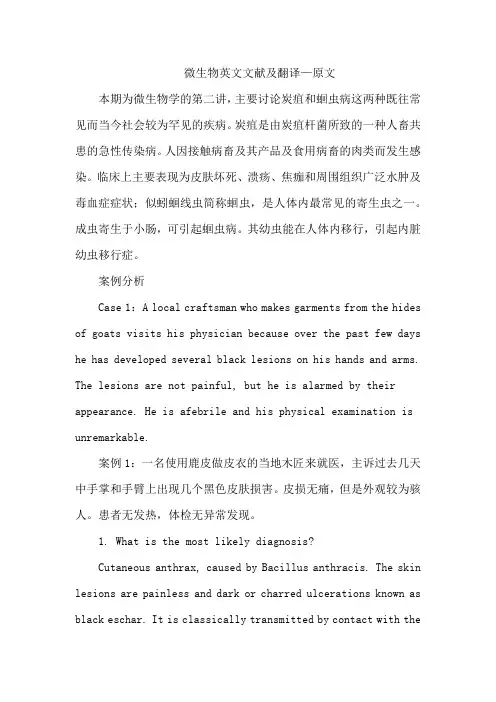
微生物英文文献及翻译—原文本期为微生物学的第二讲,主要讨论炭疽和蛔虫病这两种既往常见而当今社会较为罕见的疾病。
炭疽是由炭疽杆菌所致的一种人畜共患的急性传染病。
人因接触病畜及其产品及食用病畜的肉类而发生感染。
临床上主要表现为皮肤坏死、溃疡、焦痂和周围组织广泛水肿及毒血症症状;似蚓蛔线虫简称蛔虫,是人体内最常见的寄生虫之一。
成虫寄生于小肠,可引起蛔虫病。
其幼虫能在人体内移行,引起内脏幼虫移行症。
案例分析Case 1:A local craftsman who makes garments from the hides of goats visits his physician because over the past few days he has developed several black lesions on his hands and arms. The lesions are not painful, but he is alarmed by their appearance. He is afebrile and his physical examination is unremarkable.案例1:一名使用鹿皮做皮衣的当地木匠来就医,主诉过去几天中手掌和手臂上出现几个黑色皮肤损害。
皮损无痛,但是外观较为骇人。
患者无发热,体检无异常发现。
1. What is the most likely diagnosis?Cutaneous anthrax, caused by Bacillus anthracis. The skin lesions are painless and dark or charred ulcerations known as black eschar. It is classically transmitted by contact with thehide of a goat at the site of a minor open wound.皮肤炭疽:由炭疽杆菌引起,皮损通常无痛、黑色或称为焦痂样溃疡。
生物识别技术外文翻译文献
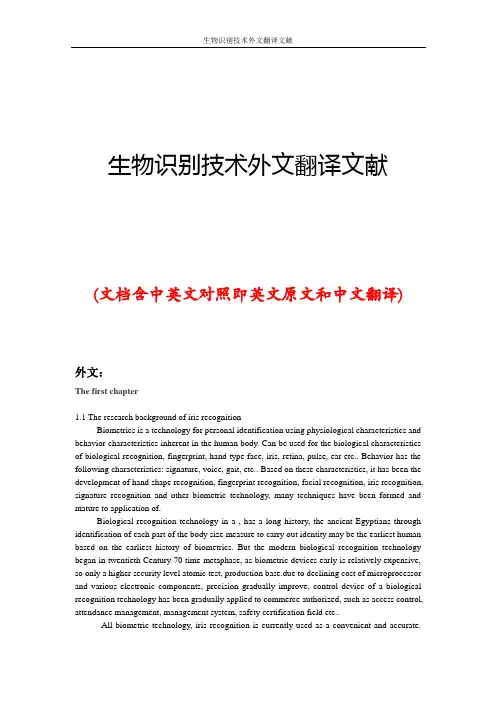
生物识别技术外文翻译文献生物识别技术外文翻译文献(文档含中英文对照即英文原文和中文翻译)外文:The first chapter1.1 The research background of iris recognitionBiometrics is a technology for personal identification using physiological characteristics and behavior characteristics inherent in the human body. Can be used for the biological characteristics of biological recognition, fingerprint, hand type face, iris, retina, pulse, ear etc.. Behavior has the following characteristics: signature, voice, gait, etc.. Based on these characteristics, it has been the development of hand shape recognition, fingerprint recognition, facial recognition, iris recognition, signature recognition and other biometric technology, many techniques have been formed and mature to application of.Biological recognition technology in a , has a long history, the ancient Egyptians through identification of each part of the body size measure to carry out identity may be the earliest human based on the earliest history of biometrics. But the modern biological recognition technology began in twentieth Century 70 time metaphase, as biometric devices early is relatively expensive, so only a higher security level atomic test, production base.due to declining cost of microprocessor and various electronic components, precision gradually improve, control device of a biological recognition technology has been gradually applied to commerce authorized, such as access control, attendance management, management system, safety certification field etc..All biometric technology, iris recognition is currently used as a convenient and accurate.Making twenty-first Century is information technology, network technology of the century, is also the human get rid of traditional technology, more and more freedom of the century. In the information, free for the characteristics of the century, biometric authentication technology, high-tech as the end of the twentieth Century began to flourish, will play a more and more important role in social life, fundamentally change the human way of life . Characteristics of the iris, fingerprint, DNA the body itself, will gradually existing password, key, become people lifestyle, instead of at the same time, personal data to ensure maximum safety, maximize the prevention of various types of crime, economic crime.Iris recognition technology, because of its unique in terms of acquisition, accuracy and other advantages, will become the mainstream of biometric authentication technology in the future society. Application of safety control, the customs import and export inspection, e-commerce and other fields in the future, is also inevitable in iris recognition technology as the focus. This trend, now in various applications around the world began to appear in the.1.2 Objective and significance of iris recognitionIris recognition technology rising in recent years, because of its strong advantages and potential commercial value, driven by some international companies and institutions have invested a lot of manpower, financial resources and energy research. The concept of automatic iris identification is first proposed by Frown, then Daugman for the first time in the algorithm becomes feasible.The iris is a colored ring in the pupil in the eye of fabric shape, each iris contains a structure like the one and only based on the crown, crystalline, filaments, spots, structure, concave point, ray, wrinkles and fringe characteristic. The iris is different from the retina, retinal is located in the fundus, difficult to image, iris can be seen directly, biometric identification technology can obtain the image of iris fine with camera equipment based on the following basis: Iris fibrous tissue details is rich and complicated, and the formation and embryonic tissue of iris details the occurrence stage of the environment, have great random the. The inherent characteristics of iris tissue is differ from man to man, even identical twins, there is no real possibility of characteristics of the same.When the iris are fully developed, he changes in people's life and tiny. In the iris outer, with a layer of transparent corneal it is separated from the outside world. So mature iris less susceptible to external damage and change.These characteristics of the iris has the advantages, the iris image acquisition, the human eye is not in direct contact with CCD, CMOS and other light sensor, uses a non technology acquisition invasion. So, as an important biometric identity verification system, iris recognition by virtue of the iris texture information, stability, uniqueness and non aggressive, more and more attention from both academic and industrial circles.1.3 Status and application of domestic and foreign research on iris recognitionIDC (International Data Group) statistics show that: by the end of 2003, the global iris recognition technology and related products market capacity will reach the level of $2000000000. Predicted conserved survey China biometric authentication center: in the next 5 years, only in the Chinese, iris recognition in the market amounted to 4000000000 rmb. With the expansion of application of the iris recognition technology, and the application in the electronic commerce domain, this number will expand to hundreds of billions.The development of iris recognition can be traced back to nineteenth Century 80's.. In 1885, ALPHONSE BERTILLON will use the criminal prison thoughts of the application of biometrics individual in Paris, including biological characteristics for use at the time: the size of the ears, feet in length, iris.In 1987, ARAN SAFIR and LEONARD FLOM Department of Ophthalmology experts first proposed the concept, the use of automatic iris recognition iris image in 1991, USA Los ala Moss National Laboratory JOHNSON realized an automatic iris recognition system.In 1993, JOHN DAUGMAN to achieve a high performance automatic iris recognition system.In 1997, the first patent Chinese iris recognition is approved, the applicant, Wang Jiesheng.In 2005, the Chinese Academy of Sciences Institute of automation, National Laboratory of pattern recognition, because of outstanding achievement "in recognition of" iris image acquisition and aspects, won the two "National Technology Invention Prize", the highest level represents the development of iris recognition technology in china.In 2007 November, "requirements for information security technology in iris recognition system" (GB/T20979-2007) national standards promulgated and implemented, the drafting unit: Beijing arithen Information Technology Co., ltd..Application of safety control, the customs import and export inspection, e-commerce and other fields in the future, is also inevitable in iris recognition technology as the focus. This trend, now in various applications around the world began to appear in the. In foreign countries, iris recognition products have been applied in a wide range.In February 8, 2002, the British Heathrow Airport began to test an advanced security system, the new system can scan the passenger's eyes, instead of to check passports. It is reported, the pilot scheme for a period of five months, a British Airways and virgin Airlines passengers can participate in this test. The International Air Transport Association interested in the results of this study are, they encourage the Heathrow Airport to test, through the iris boarding passengers to determine its identity as a boarding pass.Iris recognition system America "Iriscan" developed has been applied in the three business department of Union Bank of American Texas within. Depositors to be left with nothing whatsoever to banking, no bank card password, no more memories trouble. They get money from the A TM, a camera first eye of the user to scan, and then scan the image into digital information and data check, check the user's identity.America Plumsted school in New Jersey has been in the campus installed device of iris recognition for security control of any school, students and staff are no longer use cards and certificates of any kind, as long as they passed in the iris camera before, their location, identity is system identification, all foreign workers must be iris data logging to enter the campus. At thesame time, through the central login and access control system to carry on the control to enter the scope of activities. After the installation of the system, various campus in violation of rules and infringement, criminal activity is greatly reduced, greatly reducing the campus management difficulty.In Afghanistan, the United Nations (UN) and the United Nations USA federal agency refugee agency (UNHCR) using iris recognition system identification of refugees, to prevent the same refugee multiple receive relief goods. Use the same system in refugee camps in Pakistan and Afghanistan. A total of more than 2000000 refugees use iris recognition system, this system to a key role for the United Nations for distribution of humanitarian aid from.In March 18, 2003, Abu Zabi (one of the Arabia and the United Arab Emirates) announced the iris recognition technology for expelled foreigners iris tracking and control system based on the borders opened the world's first set of national level, this system began construction from 2001, its purpose is to prevent all expelled by Abu Zabi tourists and other personnel to enter the Abu Zabi. Without this system in the past, due to the unique characteristics of the surface of the Arabs (Hu Xuduo), and the number of the expulsion of the numerous, customs inspection staff is very difficult to distinguish between what is a deported person. By using this system, illegal immigration, all be avoided, the maximum guarantee of national security.Kennedy International Airport in New Jersey state (John F. Kennedy International Airport) of the iris recognition system installed on its international flights fourth boarding port, 300 of all 1300 employees have already started to use the system login control. By using this system, all can enter to the apron personnel must be after the system safety certification of personnel. Unauthorized want to break through, the system will automatically take emergency measures to try to force through personnel closed in the guard space. Using this system, the safety grade Kennedy International Airport rose from B+ to A+ grade. The Kennedy International Airport to travel to other parts of the passengers has increased by 18.7%.Generally speaking, the iris recognition technology has already begun in all walks of life in various forms of application in the world. At the same time, to the application of their units of all had seen and what sorts of social benefits and economic benefits are not see. This trend is to enhance the high speed, the next 10 years will be gradually achieve the comprehensive application of iris recognition in each industry.In China, due to the Chinese embargo and iris technology itself and the difficulty in domestic cannot develop products. So far, there has not been a real application of iris recognition system. However, many domestic units are expressed using strong intention, especially the "9 · 11" later, security anti terrorism consciousness has become the most concerned problems in the field of aviation, finance. Iris recognition system is a major airline companies, major financial institutions and other security mechanisms (such as aerospace bureau) become the focus of attention of object and other key national security agency. As with the trend of development in the world, iris recognition technology will in the near future in application China set off climax.The second chapter of introduction of iris recognition technology2.1 Technology of biological feature recognition based on2.1.1 Present status and development of biological feature recognition“9.11" event is an important turning point in the development of biometric ident ification technology in the world, the importance of it makes governments more clearly aware of the biological recognition technology. Traditional identity recognition technologies in the face ofdefect anti terrorism has shown, the government began a large-scale investment in the research and application of biometric technology. At the same time, the public understanding of biological recognition technology with "9.11" exposure rate and greatly improve the.The traditional method of individual identification is the identity of the people with knowledge, identity objects recognition. The so-called identity: knowledge refers to the knowledge and memory system of personal identification, cannot be stolen, and the system is easy to install, but once the identification knowledge stolen or forgotten, the identity of easily being fake or replaced, this method at present in a wide range of applications. For example: the user name and password. The so-called identity items: refers to the person, master items. Although it is stable and reliable, but mainly depend on the outer body, lost or stolen identification items once proof of identity, the identity of easily being fake or replaced, for example: keys, certificates, magnetic card, IC card etc..Biometric identification technology is related to physical characteristics, someone using prior record of behavior, to confirm whether the facts. Biometric identification technology can be widely used in all fields of society. For example: a customer came into the bank, he did not take bank card, also did not remember the password directly drawing, when he was drawing in the drawing machine, a camera to scan on his eyes, and then quickly and accurately complete the user identification and deal with business. This is the application of the iris recognition system of modern biological identification technology. "".America "9.11" after the incident, the anti terrorist activity has become the consensus of governments, it is very important to strengthen the security and defense security at the airport, some airports USA can in the crowd out a face, whether he Is it right? Wanted. This is the application of modern technology in biological feature recognition "facial recognition technology".Compared with the traditional means of identity recognition, biometric identity recognition technology in general has the following advantages:(1) the security performance is good, not easy to counterfeit or stolen.(2) carry, whenever and wherever possible, therefore more safety and security and other identification method.For the biological information of biometric recognition, its basic nature must meet the following three conditions: universality, uniqueness and permanency.The so-called universality, refers to any individual has the. Uniqueness, is in addition to other than himself, other people did not have any, namely different. The so-called permanent, refers to the character does not change over time, namely, life-long.Feature selection of organisms with more than three properties, is the first step of biological recognition.In addition, there are two important indexes in biological recognition technology. The rejection rate and recognition rate. Adjusting the relation of these two values is very important. The reject rate, the so-called false rejection, this value is high, use frequency is low, the error recognition, its value is high, safety is relatively reduced. So in the biological identification of any adjustment, the two index is a can not abandon the process. The choice of range size, related to the biological identification is feasible and available .And technology of identity recognition based on iris feature now appears, it is the development of biometric identification technology quickly, due to its uniqueness, stability,convenience and reliability, so the formation of biometric identification technology has the prospects for development.Generally speaking, the biological recognition system consists of 4 steps. The first step, the image acquisition system of collecting biometric image; the second step, the biological characteristics of image preprocessing (location, normalization, image enhancement and so on); the third step, feature information extraction, converted into digital code; the fourth step, the generation of test code and database template code to compare, make identification。
生物医学专业基因编辑外文文献翻译、中英文翻译、外文翻译
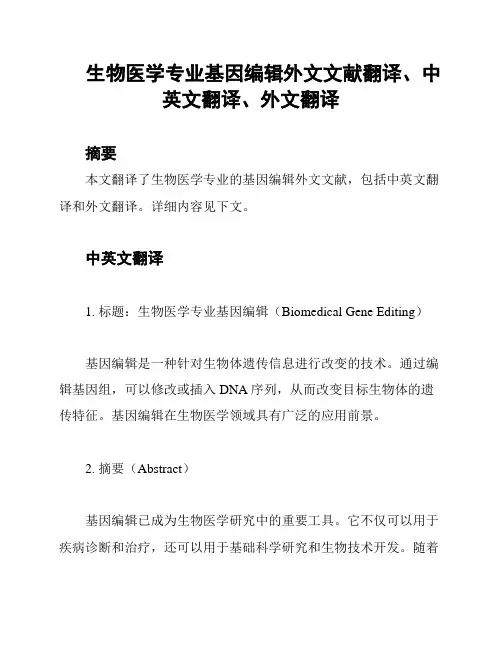
生物医学专业基因编辑外文文献翻译、中英文翻译、外文翻译摘要本文翻译了生物医学专业的基因编辑外文文献,包括中英文翻译和外文翻译。
详细内容见下文。
中英文翻译1. 标题:生物医学专业基因编辑(Biomedical Gene Editing)基因编辑是一种针对生物体遗传信息进行改变的技术。
通过编辑基因组,可以修改或插入DNA序列,从而改变目标生物体的遗传特征。
基因编辑在生物医学领域具有广泛的应用前景。
2. 摘要(Abstract)基因编辑已成为生物医学研究中的重要工具。
它不仅可以用于疾病诊断和治疗,还可以用于基础科学研究和生物技术开发。
随着技术的不断发展,基因编辑对人类健康和生物多样性的影响也引起了人们的关注。
3. 引言(Introduction)基因编辑是一种通过改变生物体的遗传信息来实现特定目的的技术。
它可以在DNA水平上对基因组进行精确的修改和操控,从而实现对目标生物体特征的变化。
外文翻译1. Title: Biomedical Gene EditingGene editing is a technology that allows for changes to be made to the genetic information of an organism. By editing the genome, DNA sequences can be modified or inserted, altering the genetic characteristics of the target organism. Gene editing has wide applications in the field of biomedical research.2. Abstract3. IntroductionGene editing is a technology that achieves specific objectives by altering the genetic information of an organism. It allows for precise modifications and manipulation of the genome at the DNA level, resulting in changes to the characteristics of the target organism.。
生物学研究内容英文版

How is Biology studied?
Insert F01-06
Scientific Method
• Begins with observations about our surroundings.
• Next, ask questions about the phenomena we are observing.
– Carry out and control numerous reactions.
What is Life?
• Living organisms:
– Grow. – Maintain constant
internal environment. – Produce offspring. – Respond to
– May be elevated to a theory = well demonstrated principle.
Figure 1• It is the study of life. • Branch of science
– A way of understanding nature.
• A human endeavor
– An attempt to understand, explain, integrate and describe the world of living things.
Scientific Method
• Followed by generating a hypothesis.
– Tentative explanation to the question.
Scientific Method
• Testing
– Scientists perform tests to determine the accuracy of their hypothesis.
微生物文献翻译
微生物文献翻译张宇生物科学2011031021Ethanol, isopropanol, and 1-butanol are the only naturally produced alcohol biofuels. Isopropanol can be used directly as a fuel supplement to gasoline or as a feedstock for the transesterification of fats into biodiesel [35]. Both isopropanol and 1-butanol are produced in a mixed product fermentation in various strains of Clostridium [36], with maximum production levels reaching 2 g/L and 20 g/L, respectively [37, 38]. With a renewed interest in alternative fuels, the production of isopropanol and 1-butanol has been recently investigated in genetically tractable heterologous organisms. These organisms, such as Escherichia coli and Saccharomyces cerevisiae, facilitate the design and optimization of new biofuels processes by combining an increasing synthetic biology toolbox with a well-studied metabolism. Isopropanol production in E. coli has surpassed that of Clostridium by assembling the pathway for acetone production and a secondary alcohol dehydrogenase [8, 12]. The production of 1-butanol, however, has proven to be more difficult. Initial efforts were able to produce ~0.5 g/L using E. coli as a host [7]. Construction of a new strain harboring a single construct resulted in an increase in production to 1.2 g/L [9]. In addition to E. coli, 1-butanol production has been investigated in Pseudomonas putida, Bacillus subtilis, and S. cerevisiae [10, 11], although production in E. coli has thus far shown the most promise. Each ofthese processes, however, is far from industrial feasibility, as yields (~0.05 g/g) and productivities (~0.01 g/L/h) must increase significantly to match the same figures for corn ethanol (~0.5 g/g and 2 g/L/h). The advancement of these processes is thought to be limited by the low activity of pathway enzymes due to poor expression, solubility, or oxygen sensitivity, as well as the metabolic imbalance introduced by these heterologous pathways. While productivity in each of these platforms is low in comparison with Clostridial fermentation, the ability to engineer and manipulate these user-friendly hosts will facilitate the development of these processes.翻译:唯一的自然生产的酒精燃料乙醇、异丙醇、和1-丁醇。
生物课程中英文对照
生物课程中英文对照(总2页)--本页仅作为文档封面,使用时请直接删除即可----内页可以根据需求调整合适字体及大小--生物课程中英文对照现代激光医学 Modern Laser Medicine生物医学光子学 Biomedicine Photonics生物医学信号处理技术 Signal Processing for Biology and Medicine自然智能与人工智能 Natural Intelligence and Artificial Intelligence人工神经网络及应用 Artificial Intelligence and Its Applications环境生物学 Environmental Biology水环境生态学模型 Models of Water Quality环境生物技术 Environmental Biotechnology水域生态学 Aquatic Ecology环境工程 Environmental Engineering环境科学研究方法 Study Methodology of Environmental Science藻类生理生态学 Ecological Physiology in Algae 水生动物生理生态学 Physiological Ecology of Aquatic Animal废水处理与回用 Sewage Disposal and Re-use 生物医学材料学及实验 Biomaterials and Experiments现代测试分析 Modern Testing Technology and Methods生物材料结构与性能 Structures and Properties of Biomaterials医学信息学 Medical Informatics组织工程学 Tissue Engineering生物医学工程概论 Introduction to Biomedical Engineering高等生物化学 Advanced Biochemistry药物化学 Pharmaceutical Chemistry功能高分子 Functional Polymer高分子化学与物理 Polymeric Chemistry and Physics医学电子学 Medical Electronics现代仪器分析 Modern Instrumental Analysis 仪器分析实验 Instrumental Analysis Experiment食品添加剂 Food Additives Technology高级食品化学 Advanced Food Chemistry食品酶学 Food Enzymology波谱学 Spectroscopy食品贮运与包装 Food Packaging液晶化学 Liquid Crystal Chemistry高等有机化学 Advanced Organic Chemistry功能性食品 Function Foods食品营养与卫生学 Food Nutrition and Hygiene 食品生物技术 Food Biotechnology 食品研究与开发 Food Research and Development有机合成化学 Synthetic Organic Chemistry 食品分离技术 Food Separation Technique精细化工装备 Refinery Chemical Equipment 食品包装原理 Principle of Food Packaging表面活性剂化学及应用 Chemistry and Application of Surfactant天然产物研究与开发 Research and Development of Natural Products食品工艺学 Food Technology食品分析 Food Analysis食品机械与设备 Food Machinery and Equipment高等无机化学 Advanced Inorganic Chemistry 量子化学(含群论) QuantumChemistry(including Group Theory)高等分析化学 Advanced Analytical Chemistry 高等有机化学 Advanced Organic Chemistry 激光化学 Laser Chemistry激光光谱 Laser Spectroscopy稀土化学 Rare Earth Chemistry材料化学 Material Chemistry生物无机化学导论 Bioinorganic Chemistry配位化学 Coordination Chemistry膜模拟化学 Membrane Mimetic Chemistry晶体工程基础 Crystal Engineering催化原理 Principles of Catalysis绿色化学 Green Chemistry现代有机合成 Modern Organic Synthesis无机化学 Inorganic Chemistry物理化学 Physics Chemistry有机化学 Organic Chemistry分析化学 Analytical Chemistry现代仪器分析 Modern Instrumental Analysis 现代波谱学 Modern Spectroscopy化学计量学 Chemomtrics现代食品分析 Modern Methods of Food Analysis天然产物化学 Natural Product Chemistry天然药物化学 Natural Pharmaceutical Chemistry现代环境分析与监测 Analysis and Monitoring of Environment Pollution现代科学前沿选论 Literature on Frontiers of Modern Science and Technology计算机在分析化学的应用 Computer Application in Analytical Chemistry现代仪器分析技术 Modern Instrument Analytical Technique分离科学 Separation Science高等环境微生物 Advanced Environmental Microorganism海洋资源利用与开发 Utilization & Development of Ocean Resources保健食品监督评价 Evaluation and Supervision on Health Food s生物电化学 Bioelectrochemistry现代技术与中药 Modern Technology and Traditional Chinese Medicine高等有机化学 Advanced Organic Chemistry 废水处理工程 Technology of Wastewater Treatment生物与化学传感技术 Biosensors & Chemical Sensors现代分析化学研究方法 Research Methods of Modern Analytical Chemistry神经生物学 Neurobiology动物遗传工程 Animal Genetic Engineering动物免疫学 Animal Immunology动物病害学基础 Basis of Animal Disease受体生物化学 Receptor Biochemistry动物生理与分子生物学 Animal Physiology and Molecular Biochemistry分析生物化学 Analytical Biochemistry学科前沿讲座 Lectures on Frontiers of the Discipline微生物学 Microbiology细胞生物学 Cell Biology生理学 Physiology电生理技术基础 Basics of Electricphysiological Technology生物化学 Biochemistry高级水生生物学 Advanced Aquatic Biology藻类生理生态学 Ecological Physiology in Algae 水生动物生理生态学 Physiological Ecology of Aquatic Animal水域生态学 Aquatic Ecology水生态毒理学 Aquatic Ecotoxicology水生生物学研究进展 Advance on Aquatic Biology水环境生态学模型 Models of Water Quality 藻类生态学 Ecology in Algae生物数学 Biological Mathematics植物生理生化 Plant Biochemistry水质分析方法 Water Quality Analysis水产养殖学 Aquaculture环境生物学 Environmental Biology专业文献综述 Review on Special Information 植物学 Botany动物学 Zoology普通生态学 General Ecology 生物统计学 Biological Statistics分子遗传学 Molecular Genetics基因工程原理 Principles of Gene Engineering 高级生物化学 Advanced Biochemistry基因工程技术 Technique for Gene Engineering 基因诊断 Gene Diagnosis基因组学 Genomics医学遗传学 Medical Genetics免疫遗传学 Immunogenetics基因工程药物学 Pharmacology of Gene Engineering高级生化技术 Advanced Biochemical Technique基因治疗 Gene Therapy肿瘤免疫学 Tumour Immunology免疫学 Immunology免疫化学技术 Methods for Immunological Chemistry毒理遗传学 Toxicological Genetics分子病毒学 Molecular Virology分子生物学技术 Protocols in Molecular Biology神经免疫调节 Neuroimmunology普通生物学 Biology生物化学技术 Biochemic Technique分子生物学 Molecular Biology生殖生理与生殖内分泌 Reproductive Physiology & Reproductive Endocrinology生殖免疫学 Reproductive Immunology发育生物学原理与实验技术 Principle and Experimental Technology of Development蛋白质生物化学技术 Biochemical Technology of Protein受精的分子生物学 Molecular Biology of Fertilization免疫化学技术 Immunochemical Technology低温生物学原理与应用 Principle & Application of Cryobiology不育症的病因学 Etiology of Infertility分子生物学 Molecular Biology 分析生物化学Analytical Biochemistry 医学生物化学 Medical Biochemistry 医学分子生物学 Medical Molecular Biology 医学生物化学技术Techniques of Medical Biochemistry 生化与分子生物学进展 Progresses in Biochemistry and Molecular Biology 高级植物生理生化Advanced Plant Physiology and Biochemistry 开花的艺术 Art of Flowering 蛋白质结构基础Principle of Protein Structure 分子进化工程Engineering of Molecular Evolution 生物工程下游技术 Downstream Technique ofBiotechnology 仪器分析 Instrumental Analysis 临床检验与诊断 Clinical Check-up & Diagnosis 药理学 Pharmacology。
生物相关专业外文文献(有翻译好的版本)
生物相关专业外文文献(有翻译好的版本)Ecological Engineering 12 1999 27–38 Combining constructed wetlands and aquatic andsoil lters for reclamation and reuse of waterCH House BA Bergmann AM Stomp DJ FrederickDepartment of Forestry North Carolina State Uniersity Box 8008 Raleigh NC 27695 8008 USAAccepted 22 May 1998 AbstractReclamation and reuse of water and nutrients at their source provide the opportunity touse simple less costly technologies and lessens potentials for catastrophic effects due tocentralized treatment system failures The combination of multiple treatment environmentswithin constructed wetlands can provide water quality suitable for reuse A current projectin rural Chatham County NC uses simple aesthetically pleasing treatment componentsconstructed both outdoors and indoors to reclaimdomestic sewage for toilet ushinglandscape irrigation and aesthetic water features A courtyard containing constructedwetlands and a solarium with modular soil lter components and aquatic chambers aredesigned to treat sewage from within a small business facility and to provide recreationalspace for its 60 employees The combination of vertical ow and horizontal ow constructedwetlands with ll and draw controls provides the necessary environments for nitrication–denitrication removal of organic materials and phosphorus adsorption reactions Thesystem is designed to treat and reuse 4500 l day 1 1200 gal day 1 of domestic sewage fromthe business Some of the plants used are selectively bred or genetically engineered toimize their water reclamation potential Utilization of simple treatment and reusetechnology has permitted the business owner to renovate an abandoned and deterioratingschool building into a home for two thriving andinternationally based businesses and toprotect the water quality of a nearby reservoir 1999 Published by Elsevier Science BV Allrights reservedKeywords Reuse Constructed wetlands Vertical ow Soil lter Fill and draw ReclamationCorresponding author0925-857499 - see front matter 1999 Published by Elsevier Science BV All rights reservedPII S0925-85749800052-428 CH House et al Ecological Engineering 12 1999 27–381 IntroductionAn effective nutrient management system for domestic sewage should reduceand reuse wastewater The general objective of this research project is to evaluatethe feasibility of treating and recycling 4500 l day 1 1200 gal day1 of domesticwastewater for ushing toilets Specic objectives include 1 the evaluation ofstep feed recirculation spatial aerobic and anaerobicenvironments uctuatingaerobic and anaerobic environments and zeolite absorbents for nitrogen treat-ment 2 the evaluation of brick chips as a phosphorus absorbent and nitrogenxing woody plants for phosphorus uptake and storage 3 develop a costeffectiveness analysis of on-site nitrogen and phosphorus treatment methods andon-site wastewater treatment and reuse within eastern Chatham CountyThe addition of human waste into high quality water and its disposal intoground and surface waters is not sustainable This practice makes inefcient useof water supply and simultaneously adversely impacts it Both on-site and central-ized treatment technologies can benet from the treatment and reuse of sewagenear its source On-site wastewater treatment design has evolved into a sophisti-cated technology with numerous advances but its adverse impacts onground andsurface waters as non-point sources of nitrogen phosphorus and pathogenicbacteria and virus continue Centralized treatment plants plagued by increasingdemands for expansion high cost and inconsistent funding mechanical or opera-tional failures periodically discharge partially treated wastewater into our surfacewatersMost water reuse research in the US currently focuses on irrigation of re-claimed wastewater from industrial and municipal sized systems North Carolinais just beginning to explore the potentials of water reuse Reduction of nutrientload and water volume through advanced treatment and reuse from installationswith small ows such as homes and businesses has potential to。
生物学英语中英对照
生物学英语中英对照1. 遗传学 Genetics基因 Gene染色体 Chromosome遗传变异 Genetic variation2. 细胞生物学 Cell Biology细胞 Cell细胞核 Nucleus细胞膜 Cell membrane3. 生态学 Ecology生态系统 Ecosystem生物多样性 Biodiversity生物群落 Biome4. 分子生物学 Molecular Biology蛋白质 Protein核酸 Nucleic acid酶 Enzyme5. 发育生物学 Developmental Biology胚胎发育 Embryonic development细胞分化 Cell differentiation形态发生 Morphogenesis6. 植物学 Botany叶绿体 Chloroplast光合作用 Photosynthesis根系 Root system7. 动物学 Zoology器官 Organ组织 Tissue神经系统 Nervous system8. 微生物学 Microbiology细菌 Bacteria病毒 Virus真菌 Fungus9. 生物化学 Biochemistry代谢 MetabolismATP(三磷酸腺苷) ATP (Adenosine Triphosphate)酶促反应 Enzymatic reaction10. 生理学 Physiology心脏 Heart肺 Lung肝脏 Liver生物学英语中英对照(续)11. 进化生物学 Evolutionary Biology自然选择 Natural selection物种形成 Speciation进化树 Evolutionary tree12. 行为生物学 Behavioral Biology繁殖行为 Reproductive behavior领域行为 Territorial behavior社会行为 Social behavior13. 神经生物学 Neurobiology神经元 Neuron突触 Synapse神经递质 Neurotransmitter14. 免疫学 Immunology抗体 Antibody免疫系统 Immune system炎症 Inflammation15. 营养学 Nutrition蛋白质 Protein碳水化合物 Carbohydrate脂肪 Fat16. 遗传工程 Genetic Engineering基因克隆 Gene cloning基因编辑 Gene editing转基因技术 Genetic modification 17. 生态遗传学 Ecological Genetics种群 Population环境适应性 Environmental adaptation遗传漂变 Genetic drift18. 生物信息学 Bioinformatics基因组学 Genomics蛋白质组学 Proteomics生物数据挖掘 Bioinformatics data mining19. 生物统计学 Biostatistics实验设计 Experimental design数据分析 Data analysis显著性检验 Significance test20. 环境生物学 Environmental Biology环境污染 Environmental pollution生态修复 Ecological restoration生物降解 Biodegradation这份生物学英语中英对照文档旨在帮助您更全面地了解生物学领域的专业术语。
- 1、下载文档前请自行甄别文档内容的完整性,平台不提供额外的编辑、内容补充、找答案等附加服务。
- 2、"仅部分预览"的文档,不可在线预览部分如存在完整性等问题,可反馈申请退款(可完整预览的文档不适用该条件!)。
- 3、如文档侵犯您的权益,请联系客服反馈,我们会尽快为您处理(人工客服工作时间:9:00-18:30)。
中英文资料外文翻译文献译文标题:传统意大利榛子的体外繁殖用于当地遗传资源库的稳定和保存译文:关键词:欧洲榛,榛属,传统种质,体外繁殖摘要:在地中海盆地,榛子(欧洲榛)是非常重要的一种作物。
体外繁殖能够有效的稳定当地遗传资源库。
为了提高榛子微组织繁殖实验记录的精确性,各种不同的研究已经在进行。
这些研究通常以重要的品种为材料,然而,微组织繁殖实验记录应用在这些幼小品种上比起传统方法通常会产生相反的结果,这种技术在幼小品种上很少取得成功。
本实验的目的是为重要品种微组织繁殖的操作积累相关的知识和信息。
实验过程中需要设计不同成分的培养基,灭菌时间和培养时间都要进行详细的讨论。
传统意大利品种植株茎芽中的N6-异戊烯腺嘌呤的作用是改善这种状态。
生根阶段是榛属微组织繁殖应用于大型商业生产的关键步骤。
欧洲榛在欧洲特别是生物地理分布区地中海盆地代表一种重要的经济类林木。
榛子主要产于土耳其,意大利,美国和西班牙(分别是每年55,000, 110,000, 25,000, 18,000+吨),其次是法国,希腊,葡萄牙。
大约90%的产品被去皮并且以树芯的形式卖出,然而剩余的10%则作为树苗消费。
极好的营养成分和营养制品的特性也使该物种产生很高的利润。
此外,在一些特有的栽培地区,传统和文化身份严重受榛子产量的影响,文化身份常常会促进贫瘠土地的回收和利用。
即使这样,在一些地区,这种林业作物仍然不是重要的农业资源,然而,就当地足够维持的生产式系统和作为宝贵的食物的传统而言,它却是一种有趣的收入来源。
世界第二大生产商意大利说一些传统的品种主要种植在Campania ,Latium, Piedmont,在西西里岛有大量的属典型种。
近几年,一些主要品种由于质量和传统特性获得了欧洲质量印模。
此外,这些品种还被引进其他国家特定的果园中以增大他们的生长范围。
没有经过检验的物质可能会传播疾病,也可能会导致原因不明的物质的出现。
微组织繁殖法等生物技术的应用会促进健康的合乎本性的物质的产生(Nas et al.,2004),并且提高这种林木的经济价值。
育种计划可以通过样本或者新品种的快速分配来加快进程。
榛子成熟组织体外快繁的一个主要障碍是高程度的内源性污染(Diaz-Sala et al.,1998),这使得培养体系的建立艰难又费时。
此外,一些培养基成分被用于促进一些主要榛属品种(Andres et al.,2002;Damiano et al.,2005;Messeguer and Mele,1987;Yu and Reed,1993)茎芽数目的增多和长度的增长。
然而,当标准化的实验设计应用于当地数目较少的品种时,实验结果是相反的,通过观察,经的生长存在一定的困难(Bacchetta et al.,2005)。
以营养成分能够保证籽苗和体外抽枝合适的生长状况的理念为基础,Nas and Read (2004)最近提出了一种新的培养基成分结构。
然而,在植物的体细胞和种子细胞之间存在着生理差别。
此外,种子内必需营养素化合物的浓度对于体细胞则太高甚至有毒。
在目前的工作中,这种状况有了轻微的改善,我们通过利用不同物种种子中大量元素和微量元素的差异来使榛子无机培养基的成分最优化,使得其中遗物中能够很好的适应体外的生长状况。
微组织繁殖法是多因素共同作用的结果,其中包括组织型和激素要求,外植体原始细胞培养阶段生理因素的影响和N6-异戊烯腺嘌呤对促进茎数目增多的影响。
这些实验目的正是一些工业机构和科研机构支持的SCRIGNO实验计划的目标,这项实验主要是为了估计当地传统型和典型物种的农业生物多样性,同时,它还支持了AGRI GEN RES 068 Safenut EU计划中遗传资源库的鉴定、保存及利用的内容。
实验材料和试验方法榛属培养基的进展状况。
桃枣作为参考物种(Rugini and Verma, 1983),两物种无机营养素的比例作为调节MS培养基的调节因子(Murashige and Skoog, 1962)。
培养基中刚开始培养的是种子,因此,此营养素成分必须尽可能的接近体细胞组织对营养素的要求。
通过原生质发射光谱法来估计无机组分的应用于意大利中部果园搜集的(100g)杏仁和榛子的嫩叶和裸露种子样本。
这种新型培养基的研究过程如下:含盐MS培养基中阴阳离子的测定;榛子和杏仁种子中无机元素浓度比例的测定;校正系数用于计算阴离子和阳离子数量和测定新的盐浓度;KH2PO4中钾的含量少于磷的含量时,KI的量不发发生变化。
新的营养成分构成改良培养基,通过改良培养基我们可以进行HM诱导,辅以含有维生素的MS培养基,加入200mg·L-1的肌醇,0.4 mg·L-1赤霉素,0.05 mg·L-1吲哚乙酸(IBA) ,3% 的蔗糖,BA (0.5 mg·L-1)。
外植体的来源。
组织培养首先要收集盆栽植物茎部分离部分(1cm长)。
这些生长2年的植物分别来自六个意大利品种的根出条。
这些根出条于2003年2月被种植于含有1:1:1粘土,沙,泥炭混合物的直径为30厘米的塑料容器。
这些被称为母体植株的盆栽植物在自然光的照射下,并定期施肥,修剪,进行杀菌处理。
灭菌过程。
外植体在自来水中用消毒剂于抗菌性药皂冲洗一小时,将植物漂洗干净。
灭菌结束后将植株放入70%乙醇中浸泡5秒。
重新切割,外植体表面用0.05%次氯酸钠的消毒10分钟,滴加几滴Tween-20,然后将植体在无菌蒸馏水冲洗三次。
10分钟次氯酸钠和几滴Tween-20只用于在冬季采集外植体。
接种到培养基之前,每个外植体基底两端分别翻新,有利于营养物质的吸收。
体外培养的建立和生根。
单节外植体取自于植物的两个不同的生理阶段:快速增长和休眠期接种于HM诱导培养基。
在继代培养时,高压灭菌后的HM培养基中加入加入BA(1.5 mg·L-1) 和N6-异戊烯腺嘌呤(1 mg·L-1)以促进其增值。
生根刺激:1)茎的基部浸入1 mg·L-1的IBA溶液20s,然后将外植体在没有激素的HM 培养基中培养20天。
或者2)在含有1/3 HM培养基营养素成分与2 mg·L-1的IBA的培养基中培养一个月。
不同的学者认为,中等浓度的矿物质浓度可以提高生根率。
培养液的PH调到5.7,然后加入0.7% (w/v)的琼脂,121℃条件下高压灭菌20分钟。
外植体培养环境设置为:室温25±1℃,16小时的光周期,70% 到80%的相对湿度。
每个塑料瓶中分装30毫升的培养基。
实验设计。
每个榛子品种的一百个辅助芽进行培养在含有30毫升培养基的单独的试管中。
每一个品种随机抽取十个重复,记录芽的数量、新叶以及茎白天的重量。
通过观察估计小植株的形状。
将实验重复一次。
用外植体培养过程中记录的外植体数,平均芽长和腋芽数进行统计分析。
统计分析采用SPSS完成(13.0,SPSS软件,芝加哥):描述性分析和普通线性分析。
结果与讨论榛子校正培养基。
表1包含榛子和杏仁的坚果和树叶中大量元素和微量元素的浓度。
差别主要体现在硼,钡,锰,铜,硅,锶的浓度上,表明榛子具有相对大的元素浓度。
另一方面,榛子所含铁和锌浓度较低。
Mobdilene并未在坚果和叶片中发现。
其中大量元素,钙,镁的含量在榛属中低于李属。
新型培养基HM与传统培养基的不同之处,见表2。
比起MS 培养基,HM培养基中含有少量的的氯化钙、硫酸镁、硫酸钾和磷酸二氢钾,这是MS和NRM中没有的成分。
另一方面,在HM中锌浓度减少到MS和NRM中锌含量的1/4。
即使实验表明,葡萄糖和果糖对于茎的伸长具有促进作用,蔗糖仍被作为为碳源;记录含有乳糖的培养基中芽的形状与生长习性(数据未显示)。
关于榛子,Yu and Reed报道过类似的结果,蔗糖作为替代碳源可以促进树种茎的伸长和提高繁殖率被Ding et al.(1985年) 和Marino et al.(1993年)报道过。
接种阶段。
榛快繁的局限性主要是外植体微组织繁殖能力的降低和植物材料的污染比较严重。
Damiano et al.在2005年报道说大约95%的外植体都会受到污染,掩盖了体外快繁的优势。
高压灭菌比起直接处理材料会减少20%到30%的内生菌污染,可以提高母体植株的利用率。
图1图2芽消毒产品也比较敏感,出现组织坏死的情况。
这种现象很普遍,特别是在外植体的生长过程中。
乙汞硫代水杨酸钠比次氯酸钠效果更好,因为它渗入细胞却不会引起组织坏死(数据未显示)。
此外,根据研究发现,对于榛子的休眠品种,离体的芽是最合适的外植体;单芽比单节外植体产生的正常植株比例高。
Messeguer and Mele(1987)就西班牙cv. Negret报道过同样的解释。
接种前去除小叶,是的组织在灭菌后更容易坏死(比有芽时高出25%)。
Damiano ed al(2005)报道说,体外培养榛子的主要困难之一是接种后芽坏死。
另一方面,低温处理提高了休眠材料体外形态发生的能力。
由于低温可以降低内生菌污染程度(表3),所以在灭菌之前榛子小枝要在5℃条件下保存三周,在灭菌过程,诱导50%而不是30%的不育材料。
培养体系的建立。
六个榛子品种对新型培养基的反应见表4。
HM培养基上的外植体长出了绿叶,在基部产生了相对较少的愈伤组织。
MS培养基上的外植体基本全部萎黄,在它们的基部几乎没有愈伤组织产生。
所有的品种芽和辅芽的长度在两种培养基上的生长状况类似。
这是培养基与基因型共同作用的结果,当培养基有利于生长时,芽的长度和每芽芽数会增加。
此外,由于培养基对芽湿重及干重的积极影响,小植株的质量会得到提高。
Nas and Read(2004)也报道说芽没有发生增殖。
然而,培养基会影响潜在的增值率,长枝更适合做继代培养。
外植体生理阶段影响芽的生长长度。
Tonda Giffoni and Tonda Romana研究表明,春季和冬季收集的外植体的差异及其在诱导培养基HM上的生长差异(图1)。
另一方面,两种外植体在Mortarella,Ghirara,Avelana Speciable和Napoletanedda培养基上表现出类似的根伸长状况。
基本上,春季收集的外植体长出的芽可以区分出不同的品种。
各种植物生长调节剂对榛子组织的不同影响也被记录。
榛子组织生长旺盛时测定出高浓度的吲哚-乙酸和细胞分裂素,这些激素促进了植物的发育。
季节和基因型的相互作用可以对芽的生长产生显著的影响。
增殖阶段。
由于低繁殖率,榛子体细胞在体外组织培养仍然受限。
春季采摘的材料在分别加有锌(1 mg·L-1)和BA (1.5 mg·L-1)的培养基上生长状况有所不同(图2)。
双向的变量分析表明品种不同,培养基不同,生长状况也会不同。
